Nanotomographic Analysis of Orthodontic Molar Tubes for Direct Bonding
Abstract
:1. Introduction
2. Materials and Methods
- -
- import of volumetric data to the software
- -
- definition (by the software) of the border between the material and the air, based on the gray scale histogram
- -
- data saving to the STL (Standard Triangulation Language) triangle mesh format
3. Results
- -
- The largest height 1 was found for Bond Sing and the lowest was found for Accent and Ortho Cast M.
- -
- Height 2 for Accent and Ortho Cast M was lower than for the remaining samples.
- -
- Height 3 was the largest for Bond Sing and the lowest for Accent.
- -
- The largest height 4 was found for Bond Sing comparing to all the remaining samples.
- -
- Height 5 was the largest for Bond Sing and the lowest for L LP
- -
- Height 6 was the largest for Bond Sing and the lowest for Ortho Cast M, L LP and Victory.
- -
- Angle 1 was significantly higher for Victory Series than for Bond Sing and Ortho Cast M. Moreover, the difference between median value and the right angle was significantly higher for L LP, Accent and Bond Sing than for Ortho Cast M, where the angle was less than 90 degrees.
- -
- Angle 2 was the closest to ideal in Accent and was significantly different compared to the other samples.
- -
- Angle 3 differed from 90 degrees significantly more for L LP, Accent, and Bond Sing than for Victory Series and Ortho Cast M.
- -
- Angle 4 was significantly higher for Bond Sing compared to all other samples; for Victory Series and L LP, the angle was less than 90 degrees; for Accent, the angle was the closest to ideal. The difference between median value and the right angle was significantly higher for Ortho Cast M than for L LP and Accent, and for Victory Series, significantly higher than for Accent.
- -
- Angle 5 was the farthest and had the greatest median value for Victory Series, and for Accent, the angle was the closest to 90 degrees.
- -
- Angle 6 was found to have a difference between median and right angle which was significantly higher for Accent than for the latter samples; moreover, for Ortho Cast M, it was significantly lower than for L LP and Bond Sing.
4. Discussion
5. Conclusions
Author Contributions
Funding
Data Availability Statement
Conflicts of Interest
References
- Arreghini, A.; Lombardo, L.; Mollica, F.; Siciliani, G. Torque expression capacity of 0.018 and 0.022 bracket slots by changing archwire material and cross section. Prog. Orthod. 2014, 25, 53. [Google Scholar] [CrossRef] [PubMed]
- Farret, M.M. Orthodontic biomechanics with intermaxillary elastics. Dental Press J. Orthod. 2023, 28, e23spe3. [Google Scholar] [CrossRef]
- Zammit, D.; Ettinger, R.E.; Sanati-Mehrizy, P.; Susarla, S.M. Current Trends in Orthognathic Surgery. Medicina 2023, 59, 2100. [Google Scholar] [CrossRef] [PubMed]
- Ahn, H.J.; Byun, S.H.; Baek, S.H.; Park, S.Y.; Yi, S.M.; Park, I.Y.; On, S.W.; Kim, J.C.; Yang, B.E. A comparative analysis of artificial intelligence and manual methods for Three-Dimensional anatomical landmark identification in dentofacial treatment planning. Bioengineering 2024, 27, 318. [Google Scholar] [CrossRef]
- Kazimierczak, N.; Kazimierczak, W.; Serafin, Z.; Nowicki, P.; Nożewski, J.; Janiszewska-Olszowska, J. AI in orthodontics: Revolutionizing diagnostics and treatment planning—A comprehensive review. J. Clin. Med. 2024, 13, 344. [Google Scholar] [CrossRef]
- Irfan, S.; Irfan, S.; Fida, M.; Ahmad, I. Contamination assessment of orthodontic bands after pre-cleaning methods at a tertiary care hospital. J. Orthod. 2019, 46, 220–224. [Google Scholar] [CrossRef]
- Radlanski, R.J.; Renz, H.; Reulen, A. Distribution of the cement film beneath the orthodontic band: A morphometric in vitro study. J. Orofac. Orthop. 2003, 64, 284–292. [Google Scholar] [CrossRef] [PubMed]
- Uysal, T.; Ramoglu, S.I.; Ertas, H.; Ulker, M. Microleakage of orthodontic band cement at the cement-enamel and cement-band interfaces. Am. J. Orthod. Dentofac. Orthop. 2010, 137, 534–539. [Google Scholar] [CrossRef]
- Erbe, C.; Hornikel, S.; Schmidtmann, I.; Wehrbein, H. Quantity and distribution of plaque in orthodontic patients treated with molar bands. J. Orofac. Orthop. 2011, 72, 13–20. [Google Scholar] [CrossRef]
- Chen, I.; Chung, J.; Vella, R.; Weinstock, G.M.; Zhou, Y.; Jheon, A.H. Alterations in subgingival microbiota during full-fixed appliance orthodontic treatment—A prospective study. Orthod. Craniofac. Res. 2022, 25, 260–268. [Google Scholar] [CrossRef]
- Kusy, R.; Whitley, J. Assessment of second-order clearances between orthodontic archwires and bracket slots via the critical contact angle for binding. Angle Orthod. 1999, 69, 71–80. [Google Scholar] [PubMed]
- Cash, A.C.; Good, S.A.; Curtis, R.V.; McDonald, F. An evaluation of slot size in orthodontic brackets—Are Standards as Expected? Angle Orthod. 2004, 74, 450–453. [Google Scholar] [PubMed]
- Meling, T.R.; Odegaard, J.; Segner, D. On bracket slot height: A methodologic study. Am. J. Orthod. Dentofac. Orthop. 1998, 113, 387–393. [Google Scholar]
- Demling, A.; Dittmer, M.P.; Schwestka-Polly, R. Comparative analysis of slot dimension in lingual bracket system. Head Face Med. 2009, 15, 5–27. [Google Scholar] [CrossRef] [PubMed]
- Bhalla, N.B.; Good, S.A.; McDonald, F.; Sherriff, M.; Cash, A.C. Assessment of slot sizes in self-ligating brackets using electron microscopy. Aust. Orthodox. J. 2010, 26, 38–41. [Google Scholar] [CrossRef]
- Joch, A.; Pichelmayer, M.; Weiland, F. Bracket slot and archwire dimensions: Manufacturing precision and third order clearance. J. Orthod. 2010, 37, 241–249. [Google Scholar] [CrossRef]
- Major, T.W.; Carey, J.P.; Nobes, D.D.; Major, P.W. Orthodontic bracket manufacturing tolerances and dimensional differences between select self-ligating brackets. J. Dent. Biomech. 2010, 27, 781321. [Google Scholar] [CrossRef]
- Pai, V.S.; Pai, S.S.; Krishna, S.; Swetha, M. Evaluation of slot size in orthodontic brackets: Are standards as expected? J. Ind. Orthod. Soc. 2011, 45, 169–174. [Google Scholar] [CrossRef]
- Brown, P.; Wagner, W.; Choi, H. Orthodontic bracket slot dimensions as measured from entire bracket series. Angle Orthod. 2015, 85, 678–682. [Google Scholar] [CrossRef]
- Ancona, M.A.; Díaz, R.R.; Rodríguez, F.M.; Olvera, S.P. Variations in slot size of self-ligating brackets: Variación en el tamaño de la ranura de brackets de autoligado. Rev. Mex. De Ortod. 2015, 3, 224–227. [Google Scholar]
- Lee, Y.; Lee, D.Y.; Kim, Y.J. Dimensional accuracy of ceramic self-ligating brackets and estimates of theoretical torsional play. Angle Orthod. 2016, 86, 804–809. [Google Scholar] [CrossRef] [PubMed]
- Alavi, S.; Tajmirriahi, F. Assessment of dimensional accuracy of preadjusted metal injection molding orthodontic brackets. Dent. Res. J. 2016, 13, 440–445. [Google Scholar]
- Erduran, R.H.; Maeda, F.A.; Ortiz, S.R.; Triviño, T.; Fuziy, A.; Carvalho, P.E. Analysis on the precision of the dimensions of self-ligating brackets. Microsc. Res. Tech. 2016, 79, 1188–1192. [Google Scholar] [CrossRef] [PubMed]
- R Core Team. R: A Language and Environment for Statistical Computing; R Foundation for Statistical Computing: Vienna, Austria, 2019; Available online: https://www.R-project.org/ (accessed on 16 October 2023).
- Floria, G.; Franchi, L. Metal injection molding in orthodontics. Virtual J. Orthod. 1997, 2, 1. Available online: http://vjo.it/five/mim (accessed on 25 June 2004).
- Vieira, E.P.; Watanabe, B.S.; Pontes, L.F.; Mattos, J.N.; Maia, L.C.; Normando, D. The effect of bracket slot size on the effectiveness of orthodontic treatment: A systematic review. Angle Orthod. 2018, 88, 100–106. [Google Scholar] [CrossRef] [PubMed]
- Moresca, R. Orthodontic treatment time: Can it be shortened? Dental Press J. Orthod. 2018, 23, 90–105. [Google Scholar] [CrossRef]
- Kłos, S.; Janiszewska-Olszowska, J. Precision of the dimensions of orthodontic bracket slots—Systematic review. Pomeranian J. Life Sci. 2019, 65, 62–71. [Google Scholar] [CrossRef]
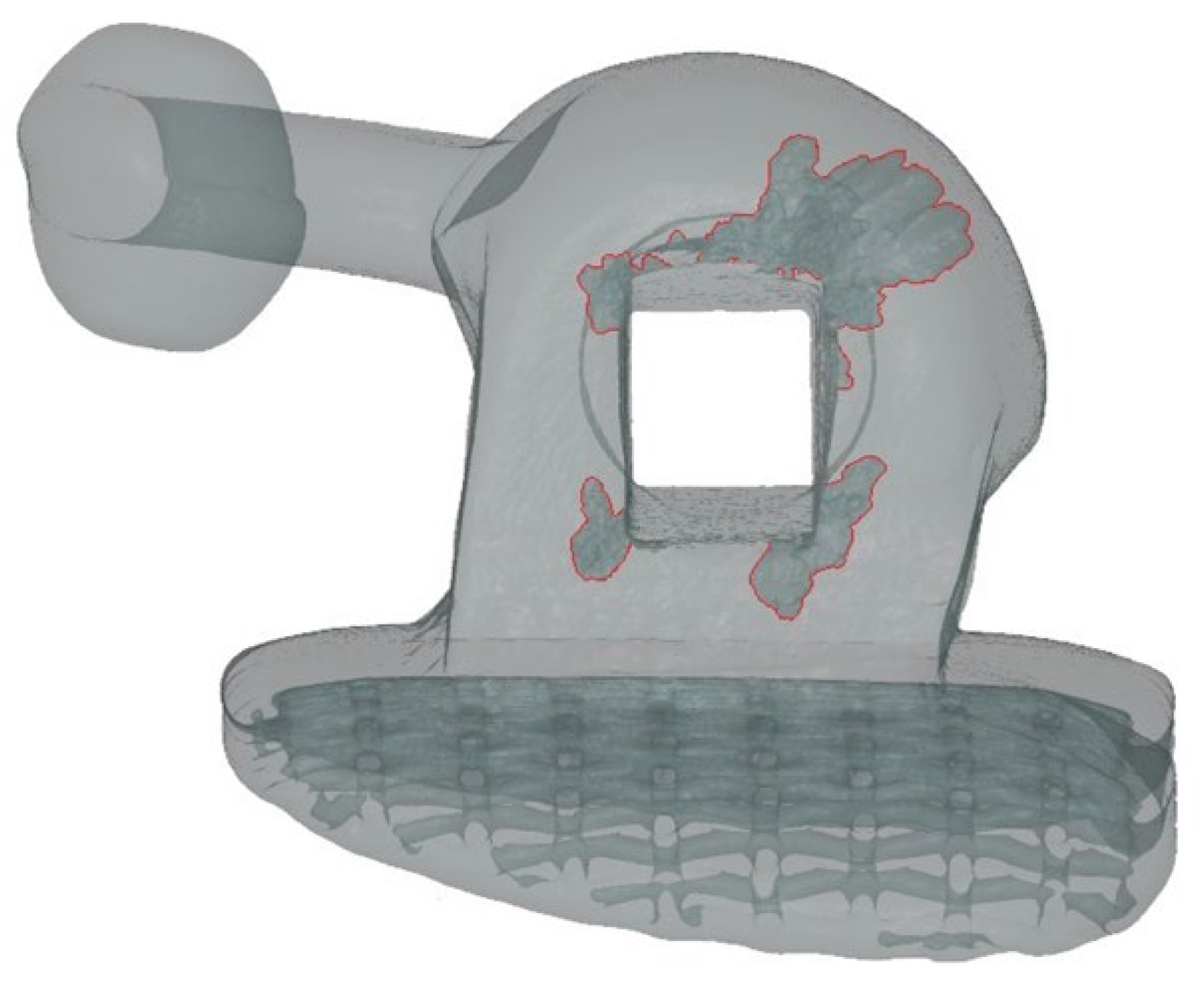
| Measurements of each tube channel dimensions | |
| Height 1 of the upper inner wall at its distal end | Height 2 of the lower inner wall at its distal end. |
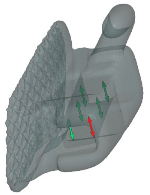 | 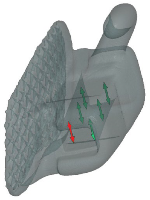 |
| Height 3 of the upper inner wall in the middle of its length | Height 4 of the lower inner wall in the middle of its length |
 |  |
| Height 5 of the upper inner wall at its mesial end | Height 6 of the lower inner wall at its mesial end |
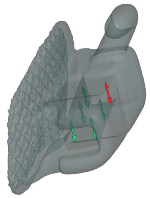 | 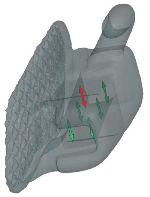 |
| Angles between the walls of each tube channel | |
| Angle between horizontal walls | Angles 1 and 2 between the walls on the distal end of the tube |
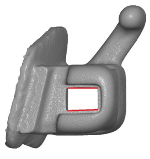 | 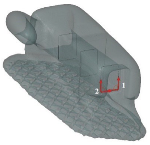 |
| Angles 3 and 4 between the walls in the middle of the tube | Angles 5 and 6 between the walls on the mesial end of the tube |
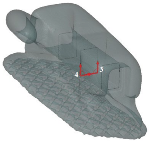 |  |
| Variable | Accent (Ormco) | Bond Sing (Adenta) | Ortho Cast M (Dentaurum) | Victory Series (3M) | L LP (GC) | p * | |
|---|---|---|---|---|---|---|---|
| Height 1 [mm] | mean ± SD | 0.56 ± 0.01 | 0.56 ± 0.12 | 0.56 ± 0.0 | 0.58 ± 0.01 | 0.57 ± 0.0 | <0.001 NP |
| median | 0.56 | 0.59 | 0.56 | 0.58 | 0.57 | ||
| Q1–Q3 | 0.56–0.57 | 0.58–0.59 | 0.56–0.57 | 0.58–0.59 | 0.56–0.57 | ||
| Height 2 [mm] | mean ± SD | 0.56 ± 0.0 | 0.57 ± 0.01 | 0.56 ± 0.0 | 0.57 ± 0.01 | 0.57 ± 0.0 | <0.001 P |
| median | 0.56 | 0.57 | 0.56 | 0.57 | 0.57 | ||
| Q1–Q3 | 0.56–0.56 | 0.57–0.58 | 0.56–0.56 | 0.57–0.58 | 0.57–0.57 | ||
| Height 3 [mm] | mean ± SD | 0.56 ± 0.0 | 0.65 ± 0.01 | 0.57 ± 0.0 | 0.57 ± 0.01 | 0.57 ± 0.0 | <0.001 P |
| median | 0.56 | 0.65 | 0.57 | 0.57 | 0.57 | ||
| Q1–Q3 | 0.56–0.56 | 0.64–0.65 | 0.56–0.57 | 0.57–0.58 | 0.57–0.57 | ||
| Height 4 [mm] | mean ± SD | 0.57 ± 0.0 | 0.63 ± 0.01 | 0.57 ± 0.0 | 0.57 ± 0.01 | 0.57 ± 0.0 | <0.001 NP |
| median | 0.57 | 0.63 | 0.57 | 0.57 | 0.57 | ||
| Q1–Q3 | 0.57–0.57 | 0.63–0.64 | 0.57–0.57 | 0.57–0.57 | 0.57–0.57 | ||
| Height 5 [mm] | mean ± SD | 0.57 ± 0.0 | 0.64 ± 0.01 | 0.57 ± 0.0 | 0.59 ± 0.0 | 0.56 ± 0.0 | <0.001 NP |
| median | 0.57 | 0.64 | 0.57 | 0.59 | 0.56 | ||
| Q1–Q3 | 0.57–0.57 | 0.63–0.64 | 0.57–0.57 | 0.58–0.59 | 0.56–0.56 | ||
| Height 6 [mm] | mean ± SD | 0.58 ± 0.0 | 0.63 ± 0.01 | 0.57 ± 0.0 | 0.57 ± 0.01 | 0.57 ± 0.0 | <0.001 P |
| median | 0.57 | 0.63 | 0.57 | 0.58 | 0.56 | ||
| Q1–Q3 | 0.57–0.58 | 0.62–0.63 | 0.57–0.57 | 0.57–0.58 | 0.56–0.57 | ||
| Angle between Horizontal Walls [Degrees] | mean ± SD | 0.04 ± 0.01 | 0.08 ± 0.03 | 0.03 ± 0.04 | 0.04 ± 0.01 | 0.02 ± 0.0 | <0.001 NP |
| median | 0.04 | 0.07 | 0.02 | 0.04 | 0.02 | ||
| Q1–Q3 | 0.03–0.04 | 0.06–0.08 | 0.02–0.02 | 0.03–0.04 | 0.02–0.02 | ||
| Angle 1 [degrees] | mean ± SD | 90.85 ± 1.21 | 90.21 ± 0.42 | 89.77 ± 0.48 | 90.85 ± 2.06 | 90.23 ± 0.22 | 0.001 NP |
| median | 90.65 | 90.15 | 89.72 | 90.77 | 90.27 | ||
| Q1–Q3 | 90.21–91.08 | 89.97–90.47 | 89.31–90 | 89.38–92.47 | 90.15–90.33 | ||
| Angle 2 [degrees] | mean ± SD | 90.05 ± 0.63 | 90.21 ± 0.45 | 89.98 ± 0.45 | 89.57 ± 0.95 | 89.32 ± 0.37 | <0.001 NP |
| median | 90.06 | 90.4 | 90.1 | 89.91 | 89.28 | ||
| Q1–Q3 | 89.68–90.54 | 90.01–90.45 | 89.8–90.24 | 88.39–91.08 | 89.11–89.53 | ||
| Angle 3 [degrees] | mean ± SD | 88.99 ± 0.76 | 90.77 ± 0.97 | 89.04 ± 0.31 | 90.93 ± 1.5 | 90.12 ± 0.6 | <0.001 NP |
| median | 88.89 | 90.35 | 89.06 | 90.75 | 89.99 | ||
| Q1–Q3 | 88.52–89.29 | 90.06–91.57 | 88.8–89.19 | 89.57–92.03 | 89.69–90.34 | ||
| Angle 4 [degrees] | mean ± SD | 90.3 ± 0.51 | 94.54 ± 2.58 | 90.75 ± 0.31 | 89.63 ± 1.58 | 89.23 ± 0.7 | <0.001 P |
| median | 90.42 | 94.01 | 90.72 | 89.69 | 89.44 | ||
| Q1–Q3 | 89.84–90.65 | 93.62–95.68 | 90.53–90.96 | 88.92–90.67 | 88.83–89.72 | ||
| Angle 5 [degrees] | mean ± SD | 89.69 ± 0.58 | 91.2 ± 7.16 | 89.61 ± 0.31 | 91.85 ± 1.4 | 88.88 ± 1.36 | <0.001 NP |
| median | 89.59 | 89.81 | 89.66 | 91.57 | 89.12 | ||
| Q1–Q3 | 89.28–90.04 | 89.44–90 | 89.39–89.81 | 90.66–93.09 | 88.93–89.3 | ||
| Angle 6 [degrees] | mean ± SD | 89.63 ± 0.51 | 87.72 ± 7.48 | 89.93 ± 0.54 | 89.04 ± 1.07 | 90.61 ± 1.35 | <0.001 NP |
| median | 89.8 | 89.32 | 89.92 | 89.35 | 90.41 | ||
| Q1–Q3 | 89.24–89.91 | 89.02–89.53 | 89.69–90.23 | 88.07–89.8 | 90.24–90.53 | ||
| Number of artifacts | mean ± SD | 0 ± 0 | 4.2 ± 1.54 | 0 ± 0 | 0 ± 0 | 0 ± 0 | <0.001 P |
| median | 0 | 4 | 0 | 0 | 0 | ||
| Q1–Q3 | 0–0 | 3–6 | 0–0 | 0–0 | 0–0 |
| Accent (Ormco) | |
 |  |
| Bond Sing (Adenta) | |
 | 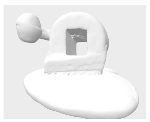 |
| Ortho Cast M (Dentaurum) | |
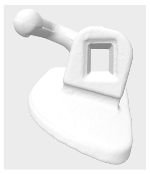 |  |
| Victory Series (3M) | |
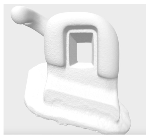 |  |
| L LP (GC) | |
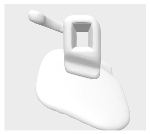 | 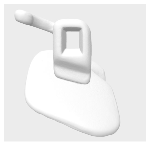 |
Disclaimer/Publisher’s Note: The statements, opinions and data contained in all publications are solely those of the individual author(s) and contributor(s) and not of MDPI and/or the editor(s). MDPI and/or the editor(s) disclaim responsibility for any injury to people or property resulting from any ideas, methods, instructions or products referred to in the content. |
© 2024 by the authors. Licensee MDPI, Basel, Switzerland. This article is an open access article distributed under the terms and conditions of the Creative Commons Attribution (CC BY) license (https://creativecommons.org/licenses/by/4.0/).
Share and Cite
Kłos, S.; Janiszewska-Olszowska, J.; Grocholewicz, K. Nanotomographic Analysis of Orthodontic Molar Tubes for Direct Bonding. Appl. Sci. 2024, 14, 4174. https://doi.org/10.3390/app14104174
Kłos S, Janiszewska-Olszowska J, Grocholewicz K. Nanotomographic Analysis of Orthodontic Molar Tubes for Direct Bonding. Applied Sciences. 2024; 14(10):4174. https://doi.org/10.3390/app14104174
Chicago/Turabian StyleKłos, Seweryn, Joanna Janiszewska-Olszowska, and Katarzyna Grocholewicz. 2024. "Nanotomographic Analysis of Orthodontic Molar Tubes for Direct Bonding" Applied Sciences 14, no. 10: 4174. https://doi.org/10.3390/app14104174
APA StyleKłos, S., Janiszewska-Olszowska, J., & Grocholewicz, K. (2024). Nanotomographic Analysis of Orthodontic Molar Tubes for Direct Bonding. Applied Sciences, 14(10), 4174. https://doi.org/10.3390/app14104174






